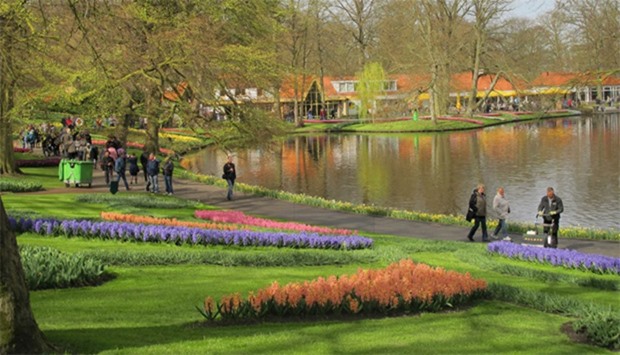The world's largest bulb garden, which boasts some seven million flowers, has depicted in flowers this year's theme of the Netherlands Golden Age.
Lasting from 1584-1702, this was a time of unparallelled prosperity for the small nation during which everything from ‘trade, art and science’ flourished, said guide Patricia Jelgehuis.
Thousands of tulips -- the country's most iconic flower -- sway gently among grape hyacinths and crocuses of every shade and hue to create the garden's colourful living tableaux.
The highlight this year is a bulb mosaic of the Golden Age, depicting a traditional Delft blue-and-white tile showing Dutch trade across the seas and Amsterdam's grand, towering canalside homes.
Other exhibits at the gardens in the western town of Lisse highlight copies of the works of famous Dutch Masters, like Rembrandt and Vermeer.
And in case the humble tulip is not enough for the 800,000 people expected to visit before the park closes again on May 16, this year's show also includes a pairing of exotic orchids with high-end fashion.
Visitors can admire dresses, shoes and hats in a bold entwining of material and flowers. There's even a creamy white wedding dress by Dutch haute couture designer Ronald Kolk, proudly displaying a cascade of orchids as part of the voluminous skirt.
Adding to the decadent display are hats by Philip Treacy, milliner to such clients as the British royal family and stars like Madonna.
It's the 67th annual springtime display at the Keukenhof gardens, created in 1857 and modelled on English gardens of the period, containing some 20 floral displays.
The bulbs are planted by hand every year by about 40 dedicated gardeners, and are set out in three layers so there is always something in bloom even if the other flowers have not yet fully opened.
‘We work to ensure that the park is as beautiful as possible for visitors but that it is also in bloom for as long as possible,’ gardener Luud ter Laak told AFP.
‘That's why we plant the bulbs in three layers. First the tulips that bloom later, then the earlier tulips and then the crocuses.’
The bulb trade in the Netherlands began in the 17th century after they were discovered in central Asia. So precious were bulbs once in the country that they were literally worth their weight in gold.

